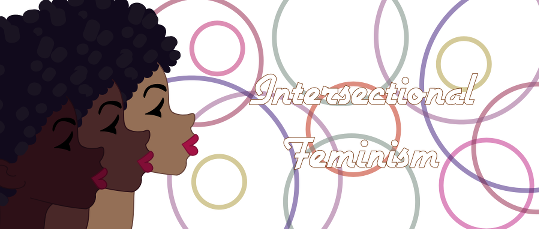Intersectionality has become a popular concept in social justice activism in the recent years. Many activists, writers, and others concerned with social justice have incorporated this concept, sometimes as an actual working tool in their repertoire, sometimes merely as a label allowing another easy grab at the “ally” cookie jar. This widespread popularity is a positive development, in that looking at the whole kyriarchy[1] is a necessity when the goal is equality and human rights for everyone, not just for your own little social corner. On the other hand, popularity is also beginning to erase the people who developed the concept and the theoretical framework from which it arose, turning it into from deeply critical social theory into a fashionable buzzword.
Intersectionality is not simply the acknowledgment that other people are oppressed too, and that some people are oppressed in several different ways; it is a theoretical framework meant to uproot the kyriarchy by acknowledging everyone’s participation in the kyriarchy as both its victim and its perpetuator. It is, in that sense, literally radical. Intersectional theory is the creation of black women academics and activists who felt ignored and ill-served by both the anti-racism and the anti-sexism movements; it came about from the need of black women to fight for their rights as black women, instead of having to divide themselves up into single-identity bits in support of movements that never acknowledged the way racism and sexism affected them as genuine representations of those oppressions. While the concept is obviously applicable to intersections other than those of race, class, and gender, that is the intersection it evolved out of, and that intersection still provides the best context for understanding how intersectional analysis manages to address the very core of our social systems, unlike many of the frameworks that preceded it.
The two women most closely associated with creating Intersectionality Theory are Kimberlé Crenshaw, for coining the term, and Patricia Hill Collins, for creating the concept of a Matrix of Domination. Crenshaw is a Professor of Law at UCLA and Columbia Law School, who has worked within the framework of black feminist legal theory and critical race studies[2]. Her work focuses on the way institutions fail women of color as a result of inadequate framing of race and gender issues. In 1989, she wrote a paper criticizing the “single-axis framework” that dominated anti-discrimination law as well feminist and anti-racist social justice work as a framework that discusses gender and racial injustice only as they apply to privileged members of these groups. According to Crenshaw, this perspective not only erases black women and other groups suffering multiple oppressions from the discussion, it fails even at the single-axis job of properly describing and analyzing gender or race oppression, since it focuses on only a small part of the many ways in which racial and gender oppression manifest in our society[3]. She makes her case by citing three legal cases in which black women had sued because of job discrimination. In these cases, black women were told on the one hand that they must prove their case either as discrimination against all women and discrimination against all black people, and on the other that they were too different from black men and white women to be representative of all women or all black people in discrimination cases[4]. Crenshaw points out that a framework in which e.g. gender discrimination must always work the way it does for white women or else not count cannot adequately deal with the fact that black women sometimes experience discrimination similar to white women; sometimes similar to black men; sometimes as double-discrimination, stacking gender and racial oppression; and sometimes, as an oppression unique to Black women, an oppression that is not simply the sum of other oppressions[5]. It is in that paper that she compared oppression to traffic at an intersection, with violence that could come from any direction or all directions all at once. And it is in that paper that she described the kyriarchy as a house with a basement in which the oppressed are stacked, with those experiencing oppressions on many axes on the very bottom, and those experiencing only one kind of oppression standing on top of them, in reach of the basement-ceiling which is also the ground floor on which the un-oppressed stand; single-axis social justice in that metaphor is a hatch in the basement ceiling, allowing those who are high enough to reach it to climb up to the ground floor, leaving those further down (and therefore unable to reach the hatch) behind[6]. Intersectionality on the other hand is meant to be a ladder which would let everyone climb out, leaving the basement empty.
Patricia Hill Collins is a Sociologist and Social Theorist who wrote a number of influential books on the topic of Intersectionality, among them Black Feminist Thought: Knowledge, Consciousness, and the Politics of Empowerment (1990); Race, Class, and Gender: An Anthology (2001, with Margaret Andersen); and Black Sexual Politics: African Americans, Gender, and the New Racism (2004)[7]. It is in the first that she presented the idea of a Matrix of Domination, created by interlocking systems of oppression and maintained, experienced, and/or resisted at multiple levels: the level of our own personal lives; the cultural or community level; and the institutional or systemic level. Collins describes how, because each person is situated in a different location within that matrix, their experience with and knowledge/understanding of the social system will be unique to them; that one of the tools of oppression is the substitution of the dominant perspective and understanding for all other perspectives, erasing and silencing subjugated knowledge and understanding of society; and that resistance to domination has to come from rejecting the dominant narratives as the universal experience of society and instead understanding them as just one of many situated knowledges produced as a result of one’s position in the matrix of domination[8]. Like Crenshaw, Collins also criticized single-axis narratives of oppression in which each person is either the oppressor or the oppressed. She presents the matrix of domination as a system in which people can function as both oppressor and oppressed, and in which systems of racial, class, and gender oppression are always present but not equally salient to each person experiencing them. At the same time, she rejects the idea that oppressions are simply stackable, and points out that playing Oppression Olympics does nothing to undo the systems maintaining the oppressive social systems[9]. Instead, she proposes to focus on the actual means by which the matrix of oppression maintains itself and how racial, gender, and class hierarchies interact within it, by analyzing the three dimensions of the matrix of domination: institutional, symbolic, and individual. The institutional dimension plays out in organizations like universities and social institutions like the education system as a whole, where in general white men still hold the most powerful positions, with white women often occupying assistive or second-tier positions, and women of color largely represented in non-academic job. The symbolic dimension is present in the way we assign concepts into boxes such as “masculine” and “feminine”, and how often these are actually specifically “white, straight, middle class masculinity” and “white, straight, middle class femininity”, and how this ideological sorting of concepts is then used as justifications for why things are the way they are; the individual dimension is the way we ourselves act within the matrix: do we resist them and connect to people who live in very different locations of the matrix, or do we accept the institutional niches and symbolic boxes? How do we manage the differences of power between individuals? etc.[10]
While Crenshaw and Collins are the most prominent black feminists and Intersectionality is generally considered to be their creation, they were not the only or the first to talk critically about the interactions of race and gender and the inadequacy of traditional social justice theories to address them. Toward A New Vision begins with a quote from Audre Lorde’s Sister Outsider, in which she references yet another scholar when she says “the true focus of revolutionary change is never merely the oppressive situations which we seek to escape, but that piece of the oppressor which is planted deep within each of us, and which knows only the oppressors’ tactics, the oppressors’ relationships”[11]. Lorde is also the author of the memorable quote “There is no such thing as a single-issue struggle because we do not live single-issue lives.”[12] And before ever the term intersectionality was invented, Barbara Smith, feminist author and member of the Combahee River Collective, talked about the “simultaneity of oppressions” which affects black women in unique ways, and which renders white-dominated feminism inadequate to the task of dismantling patriarchy for all women[13]. Meanwhile Crenshaw’s writing refers back to the 19th century, citing in her papers the black feminist scholar Anna J. Cooper, who once wrote “I see two dingy little rooms with, ‘FOR LADIES’ swinging over one and ‘FOR COLORED PEOPLE’ over the other; while wondering under which head I come”[14].
In other words, black feminists have been critically analyzing the multifaceted nature of the kyriarchy for at least a century already by the time the mainstream of social justice activism (white and/or male as it tends to be) even noticed. And now that it has, I see that it has also begun reshaping it, making it once again most useful to those who are most privileged because they are not affected by multiple oppressions. I see it being used in many mainstream social justice spaces in ways that erase the concepts of complicity in the oppression of others with a bland notion of being “in it together”; and that ignore the uniqueness and varying salience of different oppressions to different individuals in favor of universal narratives and claims of one form of domination being the main or root cause of oppression. Just as the great leaders of the social movements are often whitewashed into harmlessness, so Intersectionality is being whitewashed, made palatable to people who cannot stomach the system-shaking implications of radical social justice. This is a disservice to this highly powerful theory, and it is an injustice to the brilliant black women who have created it. Let’s remember and re-learn the roots of Intersectionality and give credit where credit is due. Let’s not weaken its impact and usefulness by trying to cram it by force and distortion into existing social justice narratives, when what it really is is a critique and replacement for single-axis social justice.
[1]http://en.wikipedia.org/wiki/Kyriarchy
[2]http://www.aapf.org/kimberle-crenshaw
[3]Crenshaw, Kimberlé. (1989). “Demarginalizing the Intersection of Race and Sex: A Black Feminist Critique of Antidiscrimination Doctrine, Feminist Theory, and Antiracist Politics”. The University of Chicago Legal Forum, Vol. 140, pp. 139-140
[4]Ibid., pp. 141-147
[5]Ibid., p. 149
[6]Ibid., pp. 151-152
[7]http://www.socy.umd.edu/facultyprofile/Collins/Patricia%20Hill
[8]Collins, Patricia Hill (1990). “Black Feminist Thought in the Matrix of Domination”. Black Feminist Thought: Knowledge, Consciousness, and the Politics of Empowerment. Boston: Unwin Hyman, pp. 221-238
[9]Collins, P.. (May 24, 1989). “Toward a New Vision: Race, Class, and Gender as Categories of Analysis and Connection.” Integrating Race and Gender into the College Curriculum: A Workshop. p. 6
[10]Ibid., pp.7-14
[11]Lorde, Audre. (1984). “Age, Race, Class and Sex: Women Redefining Difference.” Sister Outsider: Essays and Speeches, pp.114-123. Berkeley, CA: Crossing Press. p.123
[12]Lorde, Audre. (1982). “Learning from the 60s.” Sister Outsider: Essays and Speeches, pp.134-145. Berkeley, CA: Crossing Press. p. 138
[13]Smith, Barbara (ed.). (1983). “Introduction”. Home Girls: A Black Feminist Anthology. New York, NY: Kitchen Table – Women of Color Press. p. xxxiv
[14]Cooper, Anna Julia (1892). A Voice From The South. Xenia, OH: Aldine Printing House. p. 96

